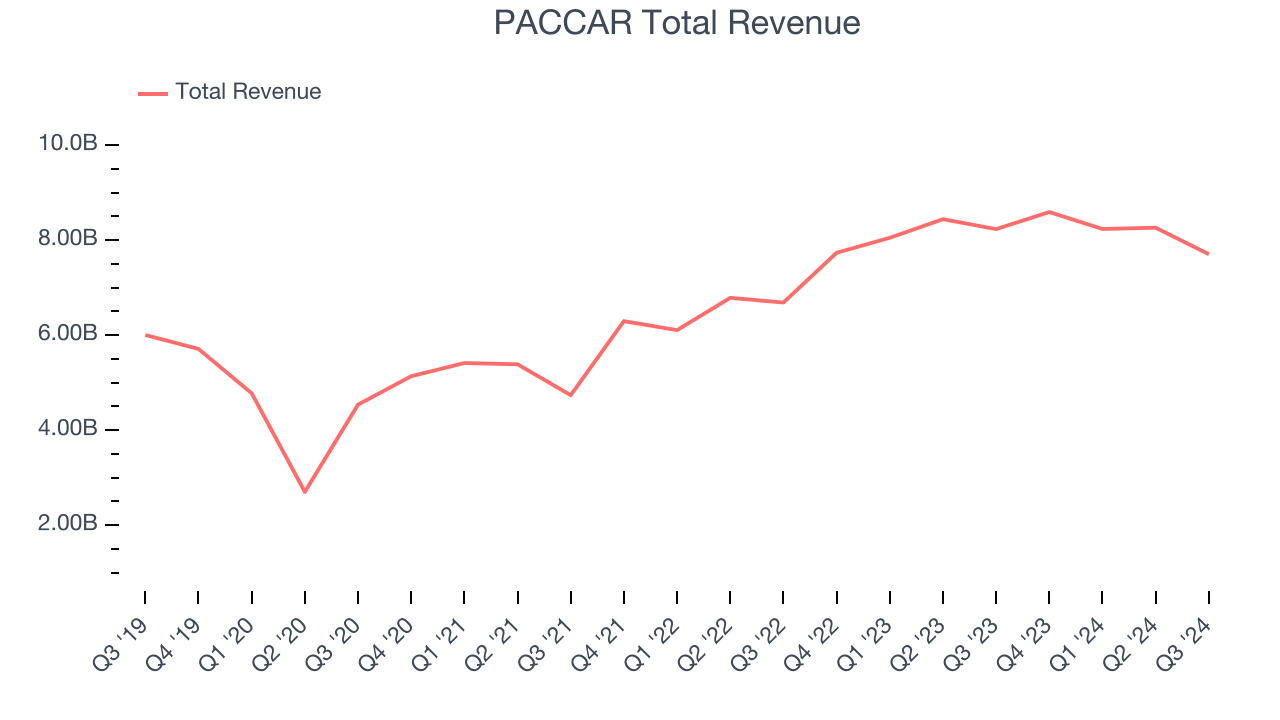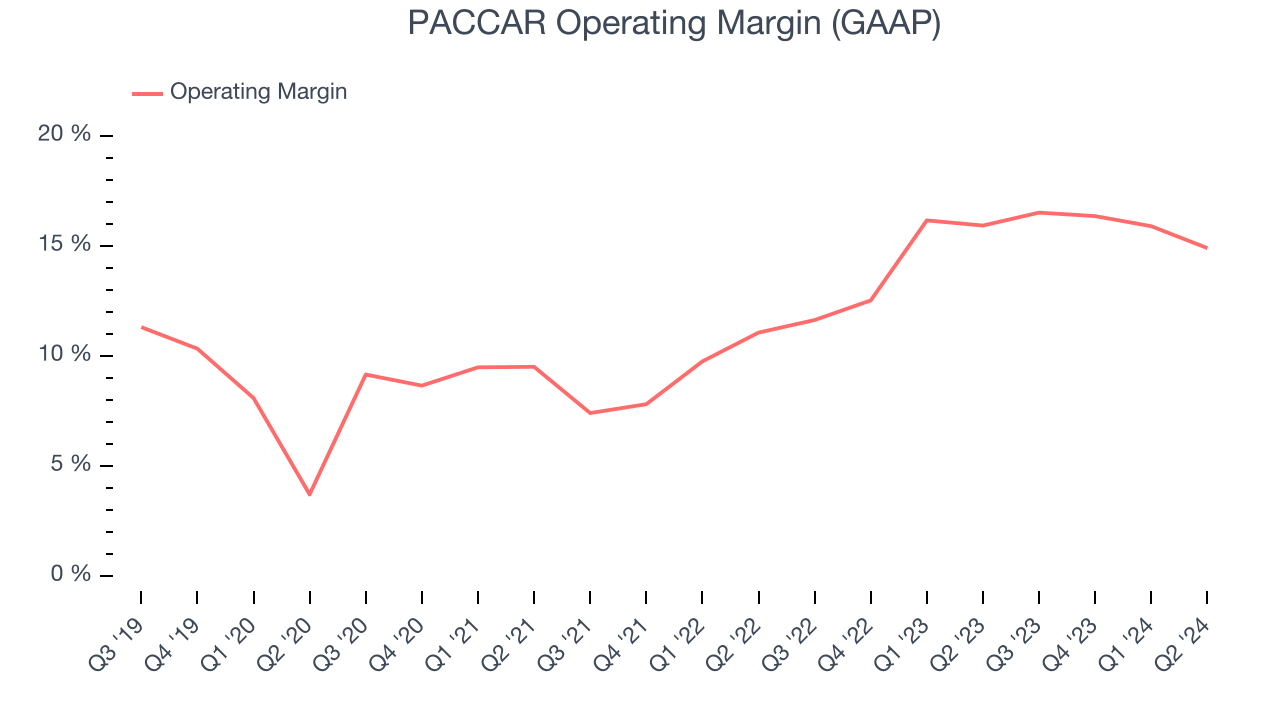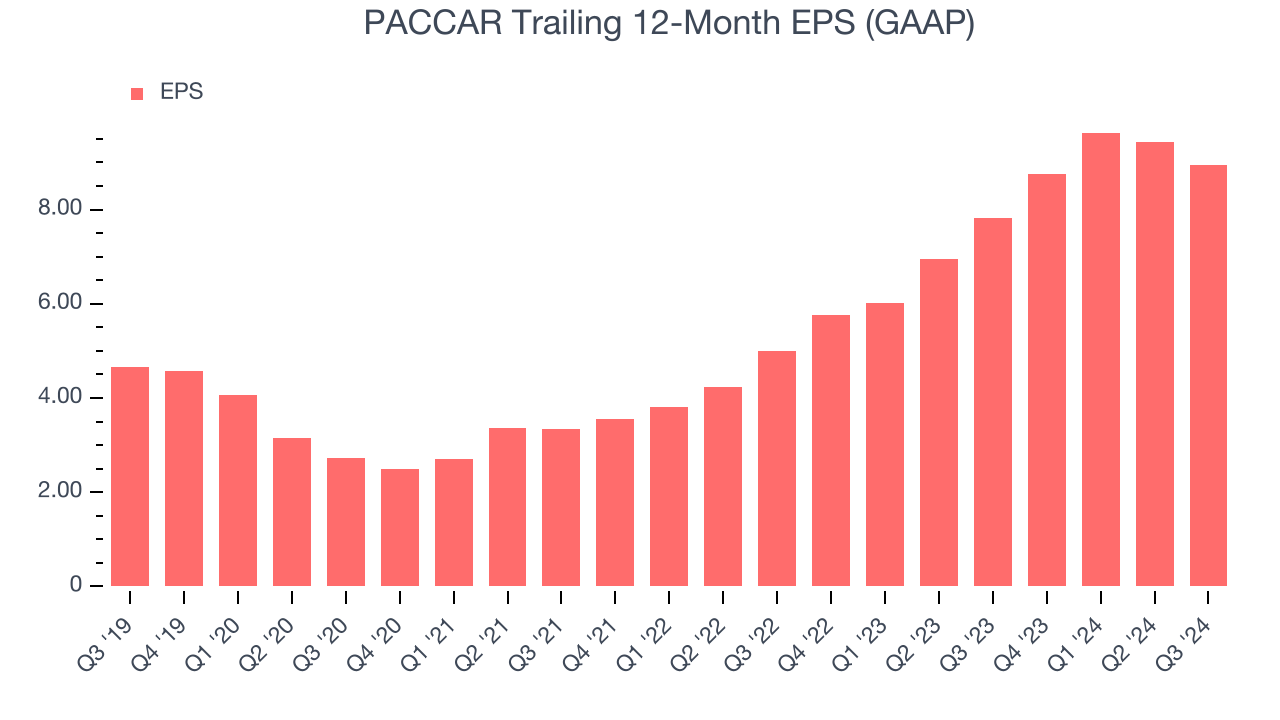Trucking company PACCAR (NASDAQ:PCAR) announced better-than-expected revenue in Q3 CY2024, but sales fell 6.4% year on year to $7.70 billion. Its GAAP profit of $1.85 per share was also 1.9% above analysts’ consensus estimates.
Is now the time to buy PACCAR? Find out by accessing our full research report, it’s free.
PACCAR (PCAR) Q3 CY2024 Highlights:
- Revenue: $7.70 billion vs analyst estimates of $7.59 billion (1.5% beat)
- EPS: $1.85 vs analyst estimates of $1.82 (1.9% beat)
- Gross Margin (GAAP): 16.6%, up from 15.5% in the same quarter last year
- Free Cash Flow Margin: 14.2%, similar to the same quarter last year
- Market Capitalization: $57.46 billion
“Kenworth and Peterbilt’s strong 31.1% market share this year reflects the superior quality and operating performance of our trucks,” said Kevin Baney, PACCAR senior vice president.
Company Overview
Founded more than a century ago, PACCAR (NASDAQ:PCAR) designs and manufactures commercial trucks of various weights and sizes for the commercial trucking industry.
Heavy Transportation Equipment
Heavy transportation equipment companies are investing in automated vehicles that increase efficiencies and connected machinery that collects actionable data. Some are also developing electric vehicles and mobility solutions to address customers’ concerns about carbon emissions, creating new sales opportunities. Additionally, they are increasingly offering automated equipment that increases efficiencies and connected machinery that collects actionable data. On the other hand, heavy transportation equipment companies are at the whim of economic cycles. Interest rates, for example, can greatly impact the construction and transport volumes that drive demand for these companies’ offerings.
Sales Growth
A company’s long-term performance can indicate its business quality. Any business can put up a good quarter or two, but many enduring ones grow for years. Over the last five years, PACCAR grew its sales at a mediocre 6.1% compounded annual growth rate. This shows it couldn’t expand in any major way and is a tough starting point for our analysis.

We at StockStory place the most emphasis on long-term growth, but within industrials, a half-decade historical view may miss cycles, industry trends, or a company capitalizing on catalysts such as a new contract win or a successful product line. PACCAR’s annualized revenue growth of 12.6% over the last two years is above its five-year trend, suggesting its demand recently accelerated.
This quarter, PACCAR’s revenue fell 6.4% year on year to $7.70 billion but beat Wall Street’s estimates by 1.5%.
We also like to judge companies based on their projected revenue growth, but not enough Wall Street analysts cover the company for it to have reliable consensus estimates. This signals PACCAR could be a hidden gem because it doesn’t get attention from professional brokers.
Here at StockStory, we certainly understand the potential of thematic investing. Diverse winners from Microsoft (MSFT) to Alphabet (GOOG), Coca-Cola (KO) to Monster Beverage (MNST) could all have been identified as promising growth stories with a megatrend driving the growth. So, in that spirit, we’ve identified a relatively under-the-radar profitable growth stock benefitting from the rise of AI, available to you FREE via this link.
Operating Margin
PACCAR has been an optimally-run company over the last five years. It was one of the more profitable businesses in the industrials sector, boasting an average operating margin of 12.2%.
Analyzing the trend in its profitability, PACCAR’s annual operating margin rose by 7.6 percentage points over the last five years, showing its efficiency has meaningfully improved.

in line with the same quarter last year. This indicates the company’s overall cost structure has been relatively stable.
Earnings Per Share
Analyzing long-term revenue trends tells us about a company’s historical growth, but the long-term change in its earnings per share (EPS) points to the profitability of that growth – for example, a company could inflate its sales through excessive spending on advertising and promotions.
PACCAR’s EPS grew at a remarkable 13.9% compounded annual growth rate over the last five years, higher than its 6.1% annualized revenue growth. This tells us the company became more profitable as it expanded.

We can take a deeper look into PACCAR’s earnings quality to better understand the drivers of its performance. As we mentioned earlier, PACCAR’s operating margin expanded by 7.6 percentage points over the last five years. This was the most relevant factor (aside from the revenue impact) behind its higher earnings; taxes and interest expenses can also affect EPS but don’t tell us as much about a company’s fundamentals.
Like with revenue, we analyze EPS over a more recent period because it can give insight into an emerging theme or development for the business. For PACCAR, its two-year annual EPS growth of 34% was higher than its five-year trend. We love it when earnings growth accelerates, especially when it accelerates off an already high base.
In Q3, PACCAR reported EPS at $1.85, down from $2.34 in the same quarter last year. Despite falling year on year, this print beat analysts’ estimates by 1.9%. Over the next 12 months, Wall Street expects PACCAR’s full-year EPS of $8.95 to shrink by 12.8%.
Key Takeaways from PACCAR’s Q3 Results
It was good to see PACCAR beat analysts’ revenue and EPS expectations this quarter. Overall, this quarter had some key positives. The stock remained flat at $108.79 immediately following the results.
Is PACCAR an attractive investment opportunity at the current price?When making that decision, it’s important to consider its valuation, business qualities, as well as what has happened in the latest quarter. We cover that in our actionable full research report which you can read here, it’s free.
